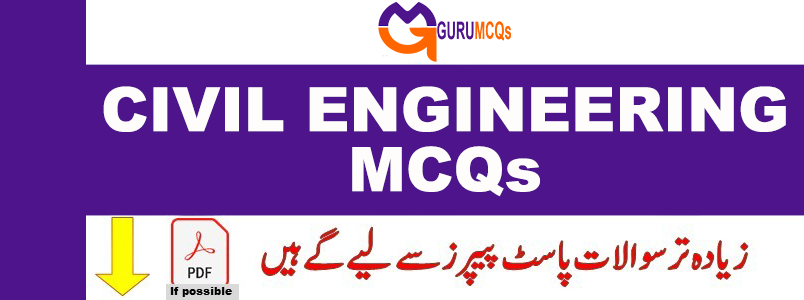
GURU MCQs provides Civil Engineering MCQs for Job Test and Interview Preparation, suitable for fresh graduates, students, and competitive exams. Most repeated civil engineering MCQs section is frequently encountered in CSS, PMS, Inspector, ASI, Sub-Inspector, Constable, FPSC, PPSC, ETEA, FIA, Police, Army, Navy, Airforce, IB, MOFA, ASF, LHC, Educators, and various other competitive exams, as well as government and private job assessments. The most common updated MCQs include Basic Civil Engineering, Building Materials, Surveying, Soil Mechanics and Foundation Engineering, Applied Mechanics, Hydraulics, Waste Water Engineering, RCC Structures Design, Irrigation, Railways, Construction Management, Theory of Structures, Estimating and Costing, Docks and Harbours, Elements of Remote Sensing, Building Construction, Concrete Technology, Advanced Surveying, Strength of Materials, Water Resources Engineering, Water Supply Engineering, Steel Structure Design, Highway Engineering, Airport Engineering, Structural Design Specifications, Tunnelling, and much more.
**161. What is the purpose of providing an expansion joint in concrete structures?**
A. To prevent cracking due to temperature changes
B. To increase the load-carrying capacity
C. To improve the aesthetic appearance
D. To reduce the cost of construction
**162. The process of compacting concrete by pressing it into the moulds is called:**
A. Vibration
B. Tamping
C. Compaction
D. None of the above
**163. The term ‘Curing’ in concrete technology refers to:**
A. Drying of concrete
B. Protecting concrete from harsh weather conditions
C. Allowing concrete to harden under controlled conditions
D. Applying a protective coating on concrete surfaces
**164. Which of the following materials is used as a fine aggregate in concrete?**
A. Gravel
B. Crushed stone
C. Sand
D. Brick chips
**165. Which of the following is NOT a type of cement?**
A. Ordinary Portland Cement (OPC)
B. Rapid Hardening Cement
C. High Alumina Cement
D. Crushed Cement
**166. The ratio of cement to sand to aggregate in concrete by volume is generally:**
A. 1:1:2
B. 1:2:4
C. 1:3:6
D. 1:4:8
**167. The process of adding water to the concrete mix to achieve the desired consistency is known as:**
A. Mixing
B. Compacting
C. Curing
D. Watering
**168. Which of the following tests is used to determine the workability of concrete?**
A. Slump test
B. Compression test
C. Tensile test
D. Flexural test
**169. The maximum size of coarse aggregate used in concrete is generally limited to:**
A. 5 mm
B. 10 mm
C. 20 mm
D. 40 mm
**170. The process of removing excess water from freshly placed concrete to enhance its strength and durability is called:**
A. Curing
B. Sealing
C. Drying
D. Bleeding

Pingback: Software Engineering MCQs for Preparation - GURU MCQS